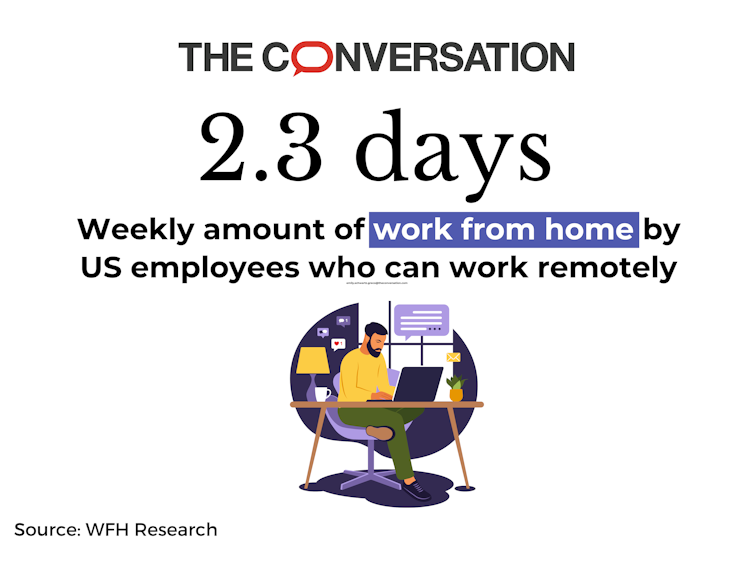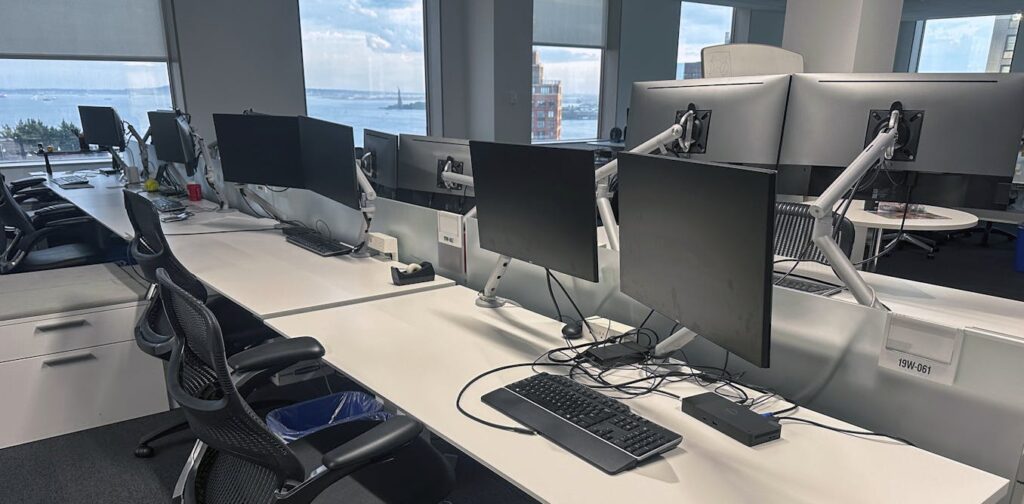
CC BY-ND
Five years after the COVID-19 pandemic reshaped office dynamics, American workplaces are evolving into a new normal. Recent research indicates that employees in remote-friendly occupations now average 2.3 days of remote work per week. When considering all workers, the average rises to 1.4 days each week, translating to 28% of paid workdays being conducted remotely.
This shift marks a significant departure from pre-pandemic norms in 2019, when remote work constituted merely 7% of total paid workdays. Although this figure has decreased from the peak of 61.5% in 2020, it is still a remarkable progression from 1965, when less than 0.5% of working days occurred outside the traditional office setup, according to the Bureau of Labor Statistics.
The Rise of Hybrid Work
In 2020, organizations rapidly adopted remote work strategies, with platforms like Zoom becoming indispensable overnight. However, as of 2024, several large employers, including JPMorgan, TikTok, and even the federal government, are pushing for a full return to office life. Yet, these stringent requirements are increasingly becoming the exception rather than the rule.
Data from Flex Index reveals a downward trend in fully in-office roles. At the start of 2023, 49% of employers mandated daily office attendance; by the end of 2024, that figure had plummeted to 32%. Furthermore, while 31% of organizations operated fully remotely in 2023, only 25% remained remote by late 2024.
The future of work appears to be embracing hybrid models, with approximately 20% of professional workplaces adopting this mixed approach in early 2023—a figure that soared to 43% within just two years.
Industry Variations in Remote Work
The landscape of remote work is not uniform; it varies significantly across different industries and geographical locations. Sectors such as technology, insurance, telecommunications, professional services, and media are among the most inclined toward long-term hybrid work arrangements.
Regionally, states like Massachusetts, Washington, Oregon, Colorado, and California are leading in remote work adoption, while states such as Kentucky, Louisiana, Nevada, Nebraska, and Alaska lag behind. These disparities often correlate with the concentration of remote-friendly industries.
Smaller businesses, particularly those with 500 or fewer employees, are more likely to adopt remote work, as maintaining communication within small teams is often more manageable. In contrast, mid-sized employers exhibit a mixed approach, while larger companies with over 25,000 employees increasingly favor hybrid setups.
Employee Preferences and Future Trends
Employee preferences for in-office, remote, and hybrid configurations have evolved during and after the pandemic. Research from Zoom reveals that in 2024, approximately 25% of professionals preferred working in an office, while 35% favored remote work, and 40% opted for hybrid arrangements. Interestingly, recent college graduates exhibited an even stronger preference for hybrid schedules at 65%.
Despite these trends, the ideal balance between remote and in-office work continues to provoke debate. While many employees seek a three-day at-home, two-day office balance, employers often prefer the reverse—three days in the office with two remote. This indicates a disconnect between employee desires and employer expectations.
The hybrid work model appears poised to dominate the future of employment, yet the fully remote work option remains a viable choice for many. This is especially beneficial for employees who are parents or caregivers, live in rural areas, or have long commutes. Additionally, individuals from marginalized communities, including many LGBTQ+ professionals, often prefer remote work to mitigate workplace microaggressions.
As we commemorate five years since the initial COVID-19 lockdown, it is clear that a one-size-fits-all approach to workplace configurations does not exist—an outcome that can be viewed positively in fostering diverse work environments.
The Evolution of Workplaces in a Post-Pandemic World
As the world adjusts to the aftermath of the COVID-19 pandemic, American workplaces are undergoing significant transformation. Research indicates that employees in roles compatible with remote work are spending an average of 2.3 days each week working from home, while all employees are working remotely about 1.4 days weekly, accounting for 28% of their total work time. This represents a dramatic shift compared to 2019, when remote work constituted just 7% of paid workdays.
In contrast to the height of the pandemic in 2020, when remote working hit a peak of 61.5%, current statistics show that although remote work has decreased, it remains a staple in American work culture. This shift is also notable when observing historical trends; back in 1965, remote work made up less than 0.5% of paid workdays. This evolution speaks volumes about how workplaces have adapted to new realities.
Rise of Hybrid Work Models
The transition to remote work was rapid and widespread in 2020. Tools like Zoom became essential, altering how teams collaborated. Fast forward five years, and many organizations, including well-known names like JPMorgan, Amazon, and TikTok, are navigating the complexities of returning to office setups. However, the majority of companies are not strictly reverting to in-person work.
As per the Flex Index, which monitors workplace strategies across over 10,000 U.S. companies, there’s a notable decline in employers insisting on full-time office attendance. At the beginning of 2023, 49% of employers required daily office presence, a figure that dropped to 32% by the end of 2024. Similarly, the number of companies functioning under a fully remote model has decreased from 31% to 25% in the same timeframe.
What’s gaining traction, however, are hybrid work arrangements, where employees split their week between home and the office. As of early 2023, hybrid setups made up about 20% of professional workplaces, which increased to 43% just two years later.
Industry-Specific Trends in Remote Work
The preferences for remote work aren’t uniform; they vary widely across different industries and regions. Sectors such as technology, insurance, telecommunications, and professional services are leading the charge in adopting long-term remote and hybrid work setups. Geographically, states like Massachusetts and California are champions of remote work, while others, including Kentucky and Alaska, lag behind.
Smaller businesses (with 500 employees or fewer) are more inclined to embrace remote work, facilitating easier connection and coordination within compact teams. Conversely, mid-sized firms are split between in-office, remote, and hybrid arrangements, while large corporations are increasingly leaning towards hybrid models.
Understanding Employee Preferences
Employees’ preferences for work environments differ greatly, influenced by their experiences during the pandemic. Current research from Zoom reveals that about 25% of workers prefer traditional office settings, while 35% would rather work remotely, and 40% favor hybrid schedules. Notably, the preferences are even more pronounced among recent graduates, with 65% opting for hybrid work options.
Despite clear preferences among employees, a mismatch exists in the ideal balance of remote and in-office work. Employees typically lean towards spending three days at home and two in the office, while employers’ expectations often reflect the opposite ratio. This divergence highlights ongoing discussions about workplace flexibility and employee satisfaction.
The Future of Work: Diversity in Workplace Choices
As workplaces adapt to the evolving landscape, a diverse array of work arrangements is emerging. For those who thrive in fully remote settings—such as parents or caretakers, individuals residing in rural areas, and those from marginalized communities—remote work offers unique advantages. Many workers cite remote options as a way to reduce workplace challenges and enhance their quality of life.
On this fifth anniversary of widespread lockdowns, it’s clear that there is no universally applicable workplace model. Embracing this diversity in work preferences and arrangements is essential for fostering an inclusive and effective work environment. This shift towards a customized approach not only benefits employees but also enhances overall workplace productivity.


